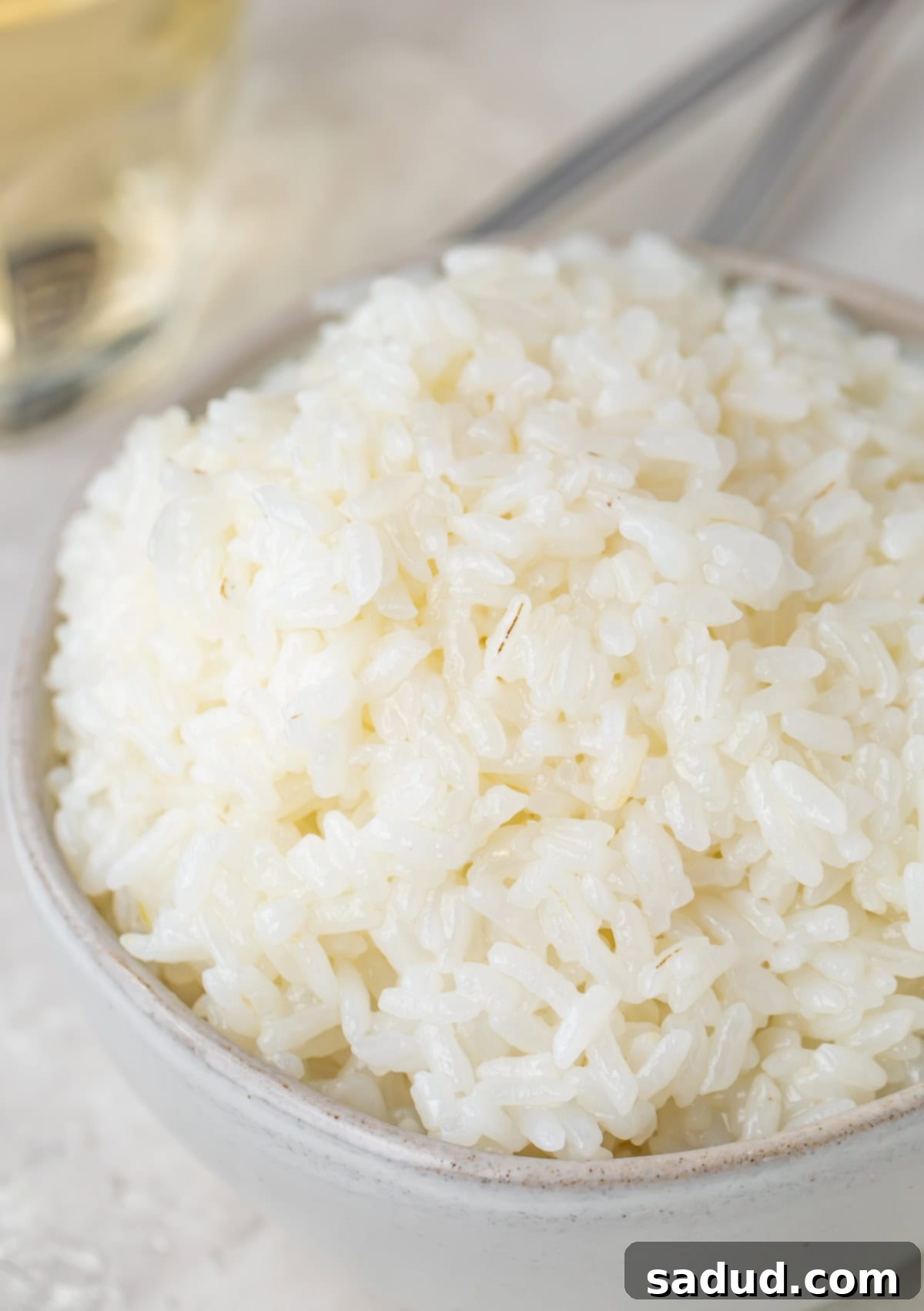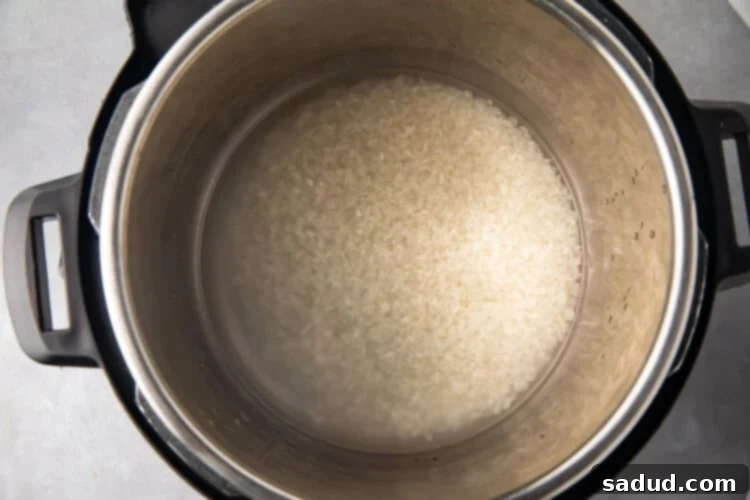Instant Pot Sushi Rice: Your Ultimate Guide to Fluffy, Flavorful Homemade Sushi
Mastering the art of sushi at home doesn’t have to be intimidating, especially when it comes to the rice. Instant Pot sushi rice is truly the simplest and most reliable method to achieve consistently fluffy, perfectly seasoned rice every single time. Forget the guesswork and uneven cooking of stovetop methods; your Instant Pot is about to become your secret weapon for creating restaurant-quality sushi rolls and vibrant sushi bowls right in your own kitchen.
This recipe delivers a harmonious blend of sweet, sour, and umami flavors, creating the ideal foundation for any sushi creation. Whether you’re craving classic nigiri, inventive maki rolls, or a deconstructed sushi bowl, this Instant Pot method guarantees rice that is sticky enough to hold together, yet tender and flavorful enough to shine. It’s not just easy; it’s a game-changer for homemade Japanese cuisine enthusiasts.
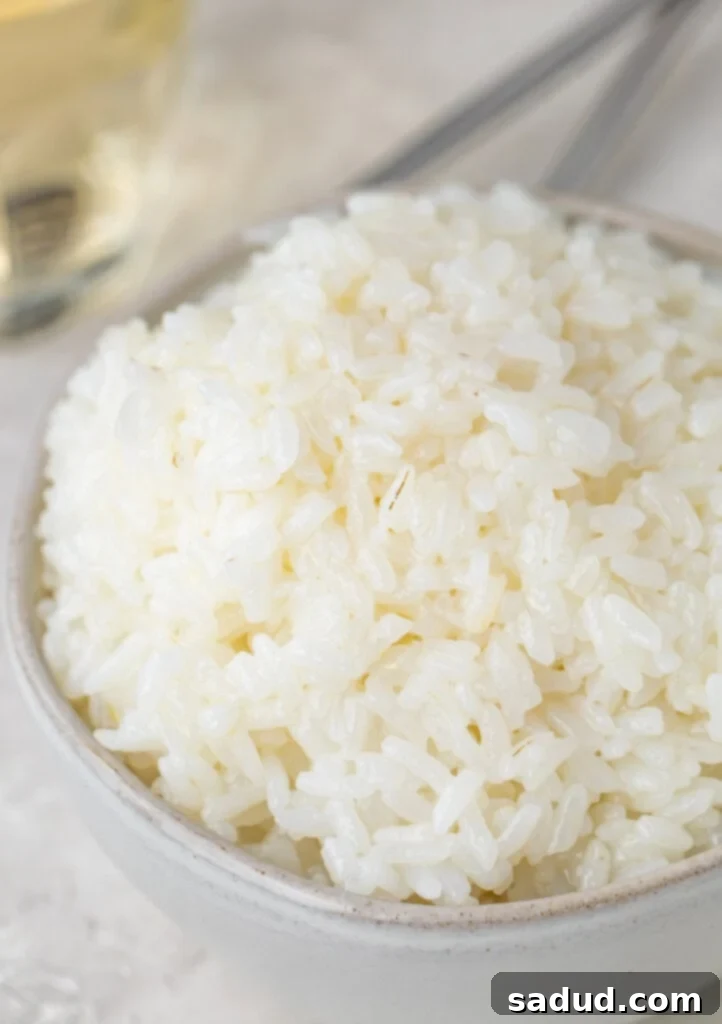
Unlocking Perfect Sushi Rice: Why This Method Stands Out
Making sushi rice can often be a delicate balance, but the Instant Pot streamlines the process, ensuring success for home cooks of all skill levels. Here’s why this approach is superior:
- Unbeatable Speed and Efficiency: Using the Instant Pot is a total game-changer, especially when it comes to rice. It’s significantly faster than traditional stovetop methods, cutting down cooking time without compromising quality. The pressure cooker environment cooks the rice more uniformly and efficiently, releasing you from constant monitoring. This means less time in the kitchen and more time enjoying your delicious creations.
- Consistently Perfect Texture: Say goodbye to burnt bottoms or undercooked grains. The Instant Pot provides a sealed, high-pressure environment that results in consistently perfect rice every single time. It creates the ideal fluffy, slightly sticky, and a little firm texture – everything you want in sushi rice. Each grain is cooked through, retaining its individual integrity while developing the characteristic stickiness essential for sushi.
- Balanced and Complementary Flavor: Flavored with a light, expertly crafted rice vinegar mixture, this sushi rice has just enough flavor to complement any of your other sushi ingredients without overpowering them. The subtle tang and sweetness enhance the freshness of fish, vegetables, or tofu, allowing each component of your sushi to truly sing. It’s the perfect canvas for your culinary artistry.
- Minimal Fuss, Maximum Flavor: The beauty of the Instant Pot lies in its set-it-and-forget-it nature. Once you’ve added your ingredients and set the timer, the Instant Pot handles the rest, allowing you to focus on preparing your other sushi components. This hands-off approach ensures a stress-free cooking experience with consistently delicious results.
Essential Ingredients for Authentic Sushi Rice
Creating truly exceptional sushi rice starts with understanding and selecting the right ingredients. Each component plays a vital role in achieving that signature texture and flavor profile.
Japanese Short-Grain Sushi Rice
Sushi Rice – The foundation of any great sushi is, of course, the rice itself. Japanese-style short-grain white rice is the absolute ideal sushi rice. Its unique starch composition (high in amylopectin) gives it that coveted slightly sticky, yet wonderfully plump and tender texture when cooked. This stickiness is crucial for holding your sushi rolls together and creating a satisfying mouthfeel.
While you might be tempted to use other varieties, it’s important to stick to short-grain or specifically labeled “sushi rice.” Jasmine or basmati rice, though fragrant and delicious in their own right, are long-grain varieties that lack the necessary starch and stickiness for sushi; they tend to be too dry and separate easily. Medium-grain rice like Calrose can be a decent substitute in a pinch, but for authentic results, always opt for short-grain Japanese sushi rice. Look for brands that clearly state “sushi rice” or “short-grain rice” on the packaging in the Asian aisle of your grocery store or at a specialty Asian market.
Unseasoned Rice Vinegar
Rice Vinegar – Don’t sleep on this! This seemingly simple ingredient is the secret weapon that elevates ordinary rice to extraordinary sushi rice. Rice vinegar gives the sushi rice that slightly sour, tangy flavor, often referred to as ‘sumeshi’ (vinegared rice), that we all know and love. Without it, your rice will taste pretty bland and won’t have that characteristic brightness that balances the other elements of sushi.
It’s crucial to use an unseasoned rice vinegar for this recipe. Unseasoned rice vinegar does not contain added salt or sugar, allowing you to precisely control the flavor profile by adding your own in this recipe. Seasoned rice vinegar, while convenient for some dishes, would throw off the delicate balance of sweetness and acidity we’re aiming for here.
Salt, Sugar, and Avocado Oil
These supporting ingredients are equally important for developing the classic sushi rice flavor and texture:
- White Sugar: A touch of white sugar balances the acidity of the rice vinegar and adds a subtle sweetness, contributing to the overall complexity of the sushi rice. This sweetness helps to round out the flavors and makes the rice more palatable.
- Salt: Essential for seasoning, salt enhances all the other flavors in the rice and is critical for that savory-sweet-sour balance. Without it, the rice can taste flat.
- Avocado Oil: A small amount of avocado oil (or another neutral oil like grapeseed or vegetable oil) is often added to the vinegar mixture. It contributes to a smoother texture and a subtle sheen, helping to keep the rice from drying out too quickly and making it easier to handle.
Master Chef’s Tips for Flawless Instant Pot Sushi Rice
Achieving truly perfect sushi rice goes beyond just the recipe; it involves a few key techniques that professional sushi chefs swear by. These tips will help you avoid common pitfalls and ensure your homemade sushi rice is nothing short of spectacular.
- The Crucial Pre-Cook Rinse: This step is non-negotiable! Don’t skip the pre-cook rinse. Rinsing the rice vigorously before cooking is essential to remove any dirt, impurities, and excess starches clinging to the outside of the grains. This excess starch can lead to mushy, clumpy rice, which is the antithesis of good sushi rice. Be sure to rinse until the water runs completely clear, typically through several changes of water. You’ll notice the water starting cloudy and gradually becoming transparent. Don’t over-rinse, though, as oversaturating the rice may lead to it absorbing too much water and changing the final texture, making it softer than desired. A good rule of thumb is 3-5 minutes of rinsing, gently agitating the rice with your hand.
- Perfecting the Vinegar Mixture: The sugar and salt in your rice vinegar mixture need to fully dissolve to evenly flavor the rice. If they don’t dissolve properly, you’ll end up with pockets of intense saltiness or sweetness, or gritty grains. If you find the sugar and salt aren’t dissolving easily in the cold oil and vinegar, you can gently heat the mixture a little in a small saucepan over low heat, or even briefly microwave it. Just warm it enough for the solids to dissolve – do not boil it. Stir until everything incorporates fully, then let it cool slightly before adding it to the cooked rice.
- The Metal Myth: Utensils and Bowls to Avoid: This is a less commonly known but crucial tip. If you can, avoid using metal bowls or utensils when you’re mixing the liquids or letting the rice cool before serving. Some metals, particularly certain types of stainless steel, can react with the acidity of the rice vinegar. This chemical reaction can impart an undesirable metallic or “funky” taste to your rice, altering its delicate flavor profile. Additionally, metal bowls heat up and cool down very quickly. If you’re letting your rice cool in a metal bowl, you may be inadvertently warming it longer than intended, which can change the consistency of your rice. Metal spoons can also be too harsh and may damage the tender rice grains, leading to a mushier texture. Opt for glass, ceramic, or wooden bowls and a wooden or silicone spoon or spatula for mixing and spreading.
- Gentle Folding for Ideal Texture: Once the rice is cooked and the vinegar mixture is ready, resist the urge to vigorously stir the liquid into the rice. The stirring motion can damage the delicate rice grains, causing them to break and release too much starch, which will ultimately make your rice mushy and pasty. Instead, just gently fold the liquid in using a cutting motion with a wooden spatula or rice paddle. Spread the rice out onto a wide, shallow non-metal dish or baking sheet to allow for even cooling and seasoning distribution, then gently fold the mixture in until it’s well incorporated.
- Cooling and Covering for Optimal Results: After seasoning, it’s vital to let the rice cool properly. Sushi rice is traditionally served at room temperature, as this allows its complex flavors to fully emerge. Spread it out on a large, flat, non-metal surface (like a wooden hangiri or a glass baking dish) and fan it gently to help it cool quickly and evenly. This also helps evaporate some of the moisture, making the grains distinct yet sticky. If you’re not using the rice immediately, keep rice covered with a damp towel to prevent it from drying out, which can make it hard and less palatable.
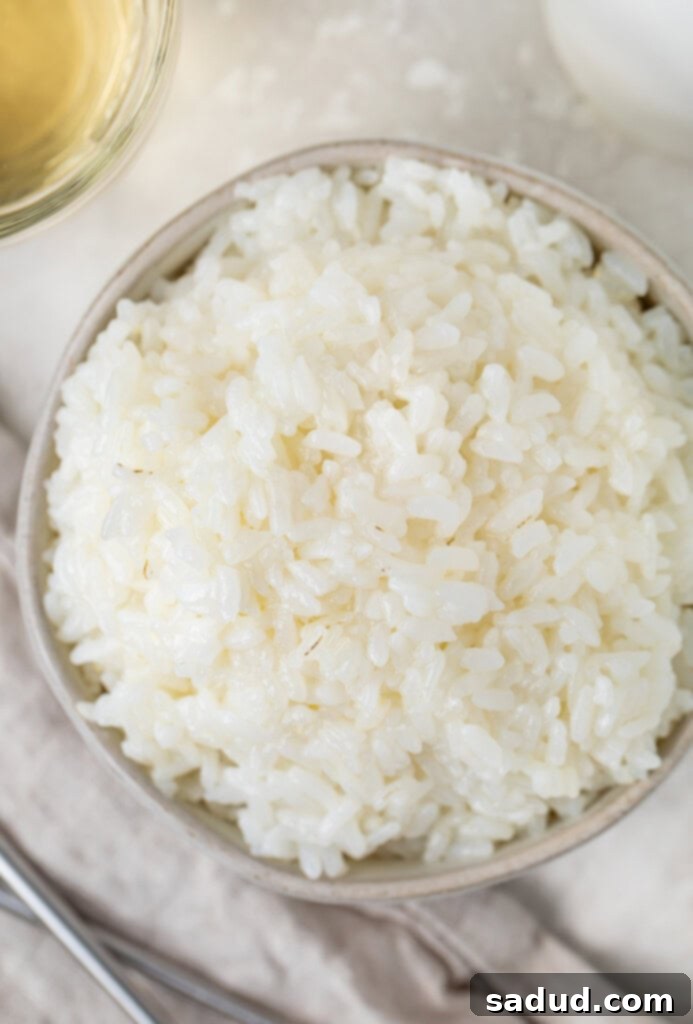
Step-by-Step Guide: Making Instant Pot Sushi Rice
Follow these simple steps to prepare perfect, fluffy sushi rice in your Instant Pot. The process is straightforward, ensuring you get consistent results every time.
If you loved this recipe as much as we did, don’t forget to leave us a review below. ★ Follow Easy Healthy Recipes on Pinterest, Facebook, and Instagram, too!
For more delicious recipes, visit our sister sites, 40 Aprons and Easy Cheap Recipes.
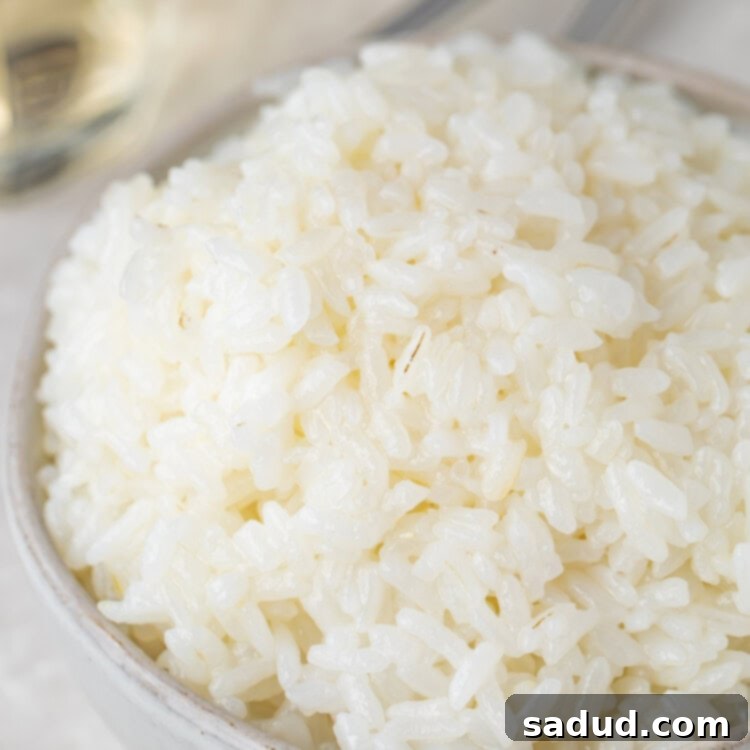
Instant Pot Sushi Rice
 Cheryl Malik
Cheryl Malik
Print
SaveSaved!
Ingredients
- 1 cup Japanese sushi rice
- 1 ¼ cups water
- 3 tablespoons rice vinegar unseasoned
- 1 teaspoon salt
- 1 tablespoon white sugar
- 1 tablespoon avocado oil
Equipment
-
Instant Pot
-
Small glass bowl
-
Wooden mixing spoon
-
Damp towel
Instructions
-
Begin by thoroughly rinsing your Japanese sushi rice. Place the rice in a fine-mesh sieve or a large bowl and rinse it under cold running water for approximately 3 minutes, or until the water runs completely clear. This crucial step removes excess starch, ensuring your sushi rice is fluffy and distinct, not mushy. After rinsing, add the clean rice and 1 ¼ cups of fresh water to the inner pot of your Instant Pot. Give it a gentle stir to ensure the rice is evenly distributed.

-
Secure the lid on your Instant Pot, making sure it’s properly sealed. Rotate the steam release valve to the “Sealing” position. Select the “Manual” or “Pressure Cook” setting and set the cooking time to “High Pressure” for 10 minutes. Once the cooking cycle is complete, allow for a Natural Release (NR) of pressure for 10 minutes. This means you do nothing and let the pressure come down on its own. After 10 minutes, carefully switch the valve to “Venting” to quick release any remaining pressure. Once the pin drops, remove the lid. The rice should be perfectly cooked and tender. Fluff the rice gently with a fork or a wooden rice paddle to separate the grains and release steam.

-
While the rice is cooking, prepare your seasoning mixture. In a small glass bowl (to avoid reactions with metal), whisk together the unseasoned rice vinegar, salt, white sugar, and avocado oil. Ensure that the sugar and salt are fully dissolved; if needed, you can gently warm the mixture for a few seconds in the microwave or over low heat. Once the rice is fluffed, transfer it to a large, shallow non-metal bowl. Pour the liquid mixture evenly over the rice. Using a wooden or silicone spatula, gently fold the liquid into the rice with a cutting motion, being careful not to mash the grains, until it’s thoroughly incorporated and each grain is coated. Let the rice come to room temperature before using for your sushi rolls or bowls. If not using immediately, cover the rice with a damp towel to keep it from drying out and maintain its perfect texture.

Notes
Recipe yields approximately 4 servings. Nutritional values shown reflect information for 1 serving. Macros may vary slightly depending on the specific brands of ingredients used. Always check your specific ingredients for the most accurate nutritional data.
To determine the size of one serving, prepare the recipe as instructed, then weigh the entire finished recipe. Divide the total weight of the recipe (not including the weight of the bowl, pot, or plate the food is in) by 4. Result will be the weight of one serving. This method provides the most accurate portion control for dietary planning.
Nutrition Information
Number of total servings shown is approximate. Actual number of servings will depend on your preferred portion sizes.
Nutritional values shown are general guidelines and reflect information for 1 serving using the ingredients listed, not including any optional ingredients. Actual macros may vary slightly depending on specific brands and types of ingredients used.
To determine the weight of one serving, prepare the recipe as instructed. Weigh the finished recipe, then divide the weight of the finished recipe (not including the weight of the container the food is in) by the desired number of servings. Result will be the weight of one serving.
Frequently Asked Questions About Instant Pot Sushi Rice
Making sushi rice at home often brings up a few questions. Here are answers to some of the most common ones to help you perfect your technique.
Can I use brown rice for sushi?
While you can make brown rice in an Instant Pot, it is not traditionally used for sushi. Brown rice has a different texture and flavor profile (nutty, chewier) that doesn’t quite achieve the characteristic stickiness and delicate taste required for authentic sushi. For the best results, stick to Japanese short-grain white rice.
How do I store leftover sushi rice?
Sushi rice is best enjoyed fresh at room temperature. If you have leftovers, transfer them to an airtight container and refrigerate for up to 1-2 days. It’s important to note that the texture of sushi rice will change after refrigeration, becoming firmer and less pliable. It’s not recommended for rolling after being refrigerated, but it can still be delicious in poke bowls or as a side dish.
Can I reheat sushi rice?
Reheating sushi rice can be tricky, as it often becomes hard or dry. To gently reheat, you can sprinkle a little water over it, cover it, and microwave it on low heat for short intervals until just warmed through. Alternatively, steaming it briefly can help restore some moisture. However, it will never be quite the same as freshly made rice.
What if my rice is too sticky or mushy?
This usually happens if you’ve used too much water, didn’t rinse the rice thoroughly enough, or stirred it too vigorously after cooking. Ensure you measure your water precisely and rinse until the water is completely clear. Remember to fold, not stir, the vinegar mixture into the rice.
What if my rice is too dry?
If your rice is too dry, it might be due to not enough water, cooking for too long, or not allowing enough natural pressure release time. Double-check your measurements and cooking times. An Instant Pot’s sealing ring should also be in good condition to prevent steam from escaping.
What to Serve with Your Perfect Instant Pot Sushi Rice
Now that you’ve mastered the art of making flawless sushi rice, the possibilities for delicious meals are endless. Here are some popular and creative ways to utilize your homemade sushi rice:
Classic Sushi Rolls (Maki)
The most obvious choice! Gather your favorite fillings like fresh salmon or tuna, cucumber, avocado, crab sticks, or cream cheese. Use a bamboo mat to roll perfect maki rolls. Don’t forget soy sauce, pickled ginger, and wasabi for the full experience.
Deconstructed Sushi Bowls (Poke Bowls)
For a quicker, easier meal, serve your sushi rice in a bowl topped with your choice of protein (raw fish, cooked shrimp, tofu, chicken), fresh vegetables (shredded carrots, edamame, radishes), and a drizzle of spicy mayo or soy-ginger dressing. It’s a versatile and satisfying meal.
Nigiri and Sashimi
If you’re feeling ambitious, shape small oval mounds of rice for nigiri and top with thinly sliced fresh fish. While sashimi is just sliced fish, serving it alongside perfect sushi rice is a delightful combination.
Onigiri (Rice Balls)
Shape the rice into triangles or other fun shapes, stuffing them with a savory filling like grilled salmon, pickled plum (umeboshi), or tuna mayo. Wrap them in a small strip of nori for an easy, portable snack or lunch.
Side Dish for Asian-Inspired Meals
Even if you’re not making sushi, this flavorful rice makes an excellent side for stir-fries, grilled fish, teriyaki chicken, or any other Asian-inspired dish where a sticky, slightly sweet and tangy rice would be a welcome addition.
More Instant Pot Recipes You’ll Love
- Instant Pot Basmati Rice
- Instant Pot Chickpeas (No Soak!)
- Perfect Whole30 Instant Pot Tomato Soup
- Instant Pot Quinoa
- Instant Pot Dal
- 50 Low Carb Instant Pot Recipes
- Instant Pot Eggs (Easy-to-Peel, Hard or Soft Boiled)
- Instant Pot Orange Chicken
- Easy Instant Pot Quinoa
- Instant Pot Black Rice (aka Forbidden Rice)
